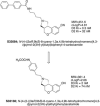Current perspectives on selective dopamine D(3) receptor antagonists as pharmacotherapeutics for addictions and related disorders
- PMID: 20201845
- PMCID: PMC3148950
- DOI: 10.1111/j.1749-6632.2009.05149.x
Current perspectives on selective dopamine D(3) receptor antagonists as pharmacotherapeutics for addictions and related disorders
Abstract
Repeated exposure to drugs of abuse produces long-term molecular and neurochemical changes that may explain the core features of addiction, such as the compulsive seeking and taking of the drug, as well as the risk of relapse. A growing number of new molecular and cellular targets of addictive drugs have been identified, and rapid advances are being made in relating those targets to specific behavioral phenotypes in animal models of addiction. In this context, the pattern of expression of the dopamine (DA) D(3) receptor in the rodent and human brain and changes in this pattern in response to drugs of abuse have contributed primarily to direct research efforts toward the development of selective DA D(3) receptor antagonists. Growing preclinical evidence indicates that these compounds may actually regulate the motivation to self-administer drugs and disrupt drug-associated cue-induced craving. This report will be divided into three parts. First, preclinical evidence in support of the efficacy of selective DA D(3) receptor antagonists in animal models of drug addiction will be reviewed. The effects of mixed DA D(2)/D(3) receptor antagonists will not be discussed here because most of these compounds have low selectivity at the D(3) versus D(2) receptor, and their efficacy profile is related primarily to functional antagonism at D(2) receptors and possibly interactions with other neurotransmitter systems. Second, major advances in medicinal chemistry for the identification and optimization of selective DA D(3) receptor antagonists and partial agonists will be analyzed. Third, translational research from preclinical efficacy studies to so-called proof-of-concept studies for drug addiction indications will be discussed.
Figures









References
-
- Levant B. The D3 dopamine receptor: neurobiology and potential clinical relevance. Pharmacol. Rev. 1997;49:231–252. - PubMed
-
- Le Foll B, et al. Dopamine D3 receptor agents as potential new medications for drug addiction. Eur. Psychiatry. 2000;15:140–146. - PubMed
-
- Richtand NM, et al. D3 dopamine receptor, behavioral sensitization, and psychosis. Neurosci. Biobehav. Rev. 2001;25:427–443. - PubMed
-
- Heidbreder CA, et al. Role of dopamine D3 receptors in the addictive properties of ethanol. Drugs Today. 2004;40:355–365. - PubMed
Publication types
MeSH terms
Substances
Grants and funding
LinkOut - more resources
Full Text Sources
Other Literature Sources
Medical

